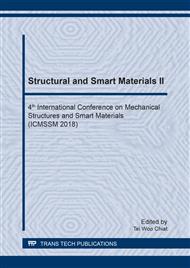p.58
p.66
p.75
p.81
p.87
p.95
p.100
p.105
p.113
Elastic Constants Determination of Composite Plates Using Measured Strains
Abstract:
A strain-based elastic constant identification method is proposed to determine the elastic constants of fiber-reinforced composite rectangular laminates using three measured strains of the plates subjected to uniaxial load testing. In the proposed method, the measured normal strains in 0°, and 45°, and 90° directions, respectively, of the plate made of one composite material subjected to uniaxial tensile testing are used to identify four elastic constants of the constituent composite material via a two-level optimization approach. The objective function used for constructing the two-level optimization problem consists of the sum of the differences between the experimental and theoretical predictions of the three strain components and a strain restraining function, which is used to help even up the effects of the measured strains on the identified elastic constants. The accuracy of the proposed method has been verified via an experimental approach.
Info:
Periodical:
Pages:
87-91
Citation:
Online since:
January 2019
Authors:
Price:
Сopyright:
© 2019 Trans Tech Publications Ltd. All Rights Reserved
Share:
Citation:


